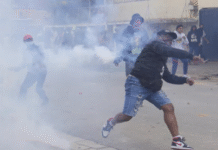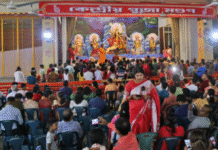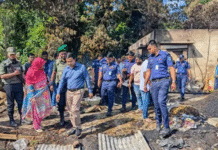The ethnic minority villages in Taindong-Tabalchari valley of Matiranga upazila in Khagrachhari are encircled by the villages of settlers from almost every corner making them highly vulnerable to their aggression.
As the recent attack by the settlers on six ethnic minority villages in Taindong union parishad shows, the aggression can take place within hours of a rumour of a kidnapping of a settler, or of a few gunshots in the vicinity.
And the Border Guards Bangladesh (BGB) personnel in six camps laying in close proximity of the area will not come to protect.
Chakma couple Suku Moni and Alo Moni of Boga Para in the union parishad have learned this lesson well again by the death of their two months’ old boy, Asha Moni Chakma.
Alo Moni did not wait for her husband to come when she heard settlers’ slogan – ‘Burn down Pahari houses, drive the Pahari’s out’ – approaching near the village. With the other villagers, she and her two children fled to a nearby jungle, and later on to the bordering Tripura state of India.
They stayed under the open sky for two days. Many of the children and the old fell ill. Alo’s two-month-old child also fell sick of pneumonia. The child was taken to the Khagrachari Hospital later and died on August 10.
Following a rumour of the kidnapping of a Bangalee settler on August 3, Suku along with 11 other Paharis went to the Crossing area in the union parishad to help the Bengalee settlers search out the so-called kidnapped person. They called on BGB commanding officer at Tanakkapara camp.
But all of them were beaten by a mob of several hundred Bangalee settlers in presence of 24 BGB personnel and 4 policemen at the Crossing.
“We went there to help them, but they beat us. The BGB didn’t do much to stop them,” Shuku said while showing his wound at his wrist. He was hacked with a da (local sharp weapon) around the wrist.
The incident of the attack in BGB presence was also admitted by the commanding officer later.
The attackers did not stop there, they moved towards the Adivasi villages. The villagers managed to escape the attack by instantly fleeing into the jungles and to the Tripura state of India, but their houses were looted, vandalised and set afire by the attackers.
Talking out their plight to the UNB Correspondent on August 16, the hapless inhabitants of Boga Para, Sorbeshwar Para and Headman Para claimed such aggression is nothing new to them.
“It happened five times this year. The entire village has to flee to the jungle, or to the India-Bangladesh border in such situation,” said Sukumar Roaza of Headman Para.
“Earlier on July 31, the people of Monudas Para, Achalong and Sorbeshwar Para had fled the villages and took shelter near the border (Bangladesh-India border), following the firing of gunshots in the vicinity. Anti-Pahari slogans were also being chanted from the mikes of mosques in the settler villages,” he said.
There are 27 mosques in Taindong. The elders and Imams of the mosques admitted that the mikes were used by some people in the locality to spread hatred against the Paharis, but without consent of the Imams and the elders who were observing Itekaf (special prayer) inside the mosques.
According to a report prepared by Hill Watch Human Rights Forum, the spate of settlers’ aggression from July 29 to August 3 has forced a total of 906 ethnic minority families in the upazila to flee their homes at two stages to the Bangladesh-India border as well as to nearby jungles, and to neighbouring Panchhari upazila.
During the attack on Bandarshing Para, Boga Para (Naya Para), Boga Para (main), Monudas Para, Sorbeshwar Para and Talukdar Para in Taindong on August 3, 259 houses, including 34 burned down houses, were ransacked and looted by the settlers.
The houses along with all other household goods of Kripa Mohon Chakma and his son Dinesh in Shorbeshwar Para were also burned to ashes. “I have no personal enmity with anyone. Rather, I have amicable relations with the Bangalees. Why will they burn my house?” he questioned.
Anita Chakma, another inhabitant of Sorbeshwar Para said she along with about 1700-1800 villagers – old, young, children – spent two days in jungles and under the open sky before the tents were offered inside the Indian territory.
“The hideout in the jungle with the children and the old was horrendous. Many fell sick. But most horrendous was when the people in India came to see us in the refuge and asked – why have you come,” she said.
“As a Bangladeshi, I felt utterly ashamed. Why do we need to flee our villages in our own country and take shelter in another country?” she questioned.
The question has been asked repeatedly over decades by millions of voices. It is not that the ethnic minorities do not understand when they are affected and displaced by the political economy of land grabbing in the CHT by the state agencies and the settlers and about the significance the communal attacks hold in the process.
The ethnic minorities in Matiranga fled to the jungles and the borders in face of communal attacks in 1981, 1984, 1986, 1989. They spent much longer in the refuge compared to the two-three days’ refuge this August. When they returned, they found out most of their lands had already been occupied by illegal settlers.
And Matiranga is not an isolated case in the CHT. The good portion of the ethnic minorities has already been forced to leave the places of their belonging several times.
Riko Chakma of Khagrachhari Sadar said he can remember his family being displaced twice – in 1986 and in 1989 – from their homes in Dighinala upazila in the district. “I still give my permanent address at Babuchara in Dighinala, although the settlers are occupying the land right now,” he said.
He said his father Purna Chandra Chakma was also displaced from his place of belonging in Rangamati district when the Kaptai dam was build.
According to a 2010 study by Bangladesh Economic Association president Prof Abul Barakat, about 22 percent of the ethnic minority households have been evicted by Bangalee settlers in the CHT from 1977 to 2007.
At least 38 percent of the ethnic minority households had to change their permanent addresses at least once during the same period, while 62 percent of the Bangalees has moved there as part of the ‘demographic and political engineering’, the study added.
Source: UNBConnect











Wherever Muslim interest is involved some way or other some quarters must intervene adversely. Within the territorial boundary of a sovereign country citizens of one place should have the right to go and settle wherever they find opportunity. But here the case is different. The tribal people are in no definition ‘adibasi’ (indigenous) people. But while the migrant Bangalees are being considered as ‘intruders’, the same thing when happened in Kashmir, nobody cared. Now most people have forgotten why Pundit Nehru conceded to hold a plebicite in Kashmir but later intentionally prolonged the process with a clandestine effort to balance Hindu – Muslim population and only then there might be a plebicite, of course if at all the UN resolution became unavoidable. But now in the guise of establishing the rights (?) of the indigenous (?) people, a clandestine effort is reported to be active to seclude the CHT from mainland Bangladesh. The govt, perhaps, is aware for which the activities of a few NGOs have been under surveillance. To be frank, withdrawal of the army from the CHT might not prove a prudent decision in the near future.